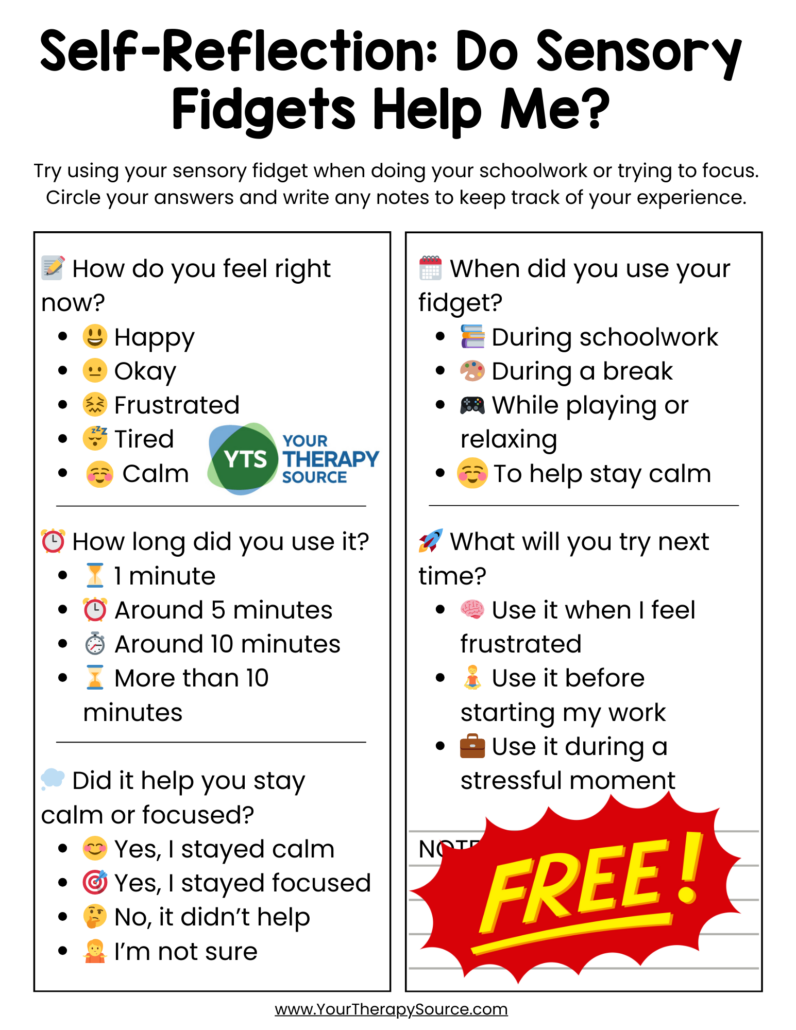Sensory Fidgets: Do They Work?
If you’ve ever wondered whether sensory fidgets help students (or yourself) stay calm and focused, you’re not alone! Sensory fidgets are widely used in classrooms, therapy rooms, and homes, but do they really work?
To help you or your students find out, you can download our FREE one-page PDF printable designed to reflect on whether the fidget works for them (or you).

WHAT ARE SENSORY FIDGETS?
Sensory fidgets are small tools that provide tactile, auditory, or visual feedback to help individuals self-regulate, reduce anxiety, and improve focus. They come in many forms, from simple stress balls to more interactive designs like textured stickers and fidget spinners. These tools are especially helpful for students who need extra support to stay calm and engaged during school activities.

Textured Sensory Stickers and Poster Set
HOW DO SENSORY FIDGETS WORK FOR STUDENTS?
The brain processes information from sensory fidgets through touch, movement, and sometimes sound. This input can help students organize their thoughts and emotions, reducing distractions. For example, when a student uses a textured fidget, such as a sensory sticker, their brain focuses on the repetitive motion and tactile input, which in turn helps them calm down, stay present, and refocus on their schoolwork. By offering a structured way to channel fidgeting, these tools can promote better learning and improved classroom behavior.
TYPES OF SENSORY FIDGETS
There are various types of sensory fidgets available, each providing unique benefits. Here are some popular types:
- Textured Stickers: These stickers, like the ones from Your Therapy Source, provide bumpy, tactile feedback that helps students calm down while working on school tasks. They can be placed on desks, notebooks, or even phone cases and are easily accessible throughout the day. These reusable stickers are perfect for sensory breaks and can help improve focus.
- Stress Balls: A classic fidget that offers squishy, tactile feedback, great for squeezing during moments of stress or frustration.
- Fidget Spinners: These spinners allow students to direct their excess energy through hand movement, helping them concentrate during lessons.
- Chewable Fidgets: Made for students who need oral input, these fidgets can be chewed discreetly to help reduce anxiety.
- Tangle Toys: These flexible toys can be twisted and turned, offering continuous sensory input to keep hands busy without being distracting.

HOW TO COMPLETE THE SELF REFLECTION SENSORY FIDGET WORKSHEET
Once you’ve downloaded the FREE Self-Reflection Sensory Fidget Worksheet, it’s simple to use. This worksheet is a great tool to help students recognize the effectiveness of their sensory fidgets and develop self-awareness in how and when to use them. Here’s how to complete it:
- How Do You Feel?
At the beginning of your activity or schoolwork, circle the emoji that best describes your mood—are you happy, frustrated, calm, or somewhere in between? - When Did You Use Your Fidget?
Think about when you decided to use your fidget. Was it during classwork, recess, or another time during the school day? Circle the option that applies to you. - How Long Did You Use It?
Track how long you used the fidget. Did you just need it for a minute or did you use it for more than 10 minutes? Choose the right time frame. - Did It Help?
After using your fidget, reflect on whether it helped you stay calm or focused. Circle the answers that best match your experience. - Plan for Next Time
In the last section, think about how you can use your fidget in the future. Will you try it when you’re frustrated or need to focus on a task? Write down any notes to remind yourself how the fidget can help next time.

Self-Assessments and Checklists for Good Work Habits
WHY SELF REFLECT ON FIDGET USE?
Self-reflection is a powerful tool to assess whether a sensory fidget is truly working for a student. By using the free downloadable worksheet, students can track how they feel before and after using a fidget, how long they used it, and whether it helped them stay calm or focused. This kind of reflection can help both educators and students better understand what works and when to use sensory tools effectively. Over time, students can develop more independence in choosing strategies that help them manage their emotions and focus on learning.
MORE HELPFUL INFORMATION
For more tips and resources on fidgets and sensory tools, check out these blog posts:
- More Data Collection for Fidgets
- Homemade Fidget Toys for ADHD
- Fidgety Child Syndrome
- Strategies for Fidgety Students
- Fidget Spinners and ADHD
DOWNLOAD YOUR FREE SENSORY FIDGET PRINTABLE TOOL
Download your FREE one-page reflection worksheet today and start exploring whether sensory fidgets work for you or your students!



